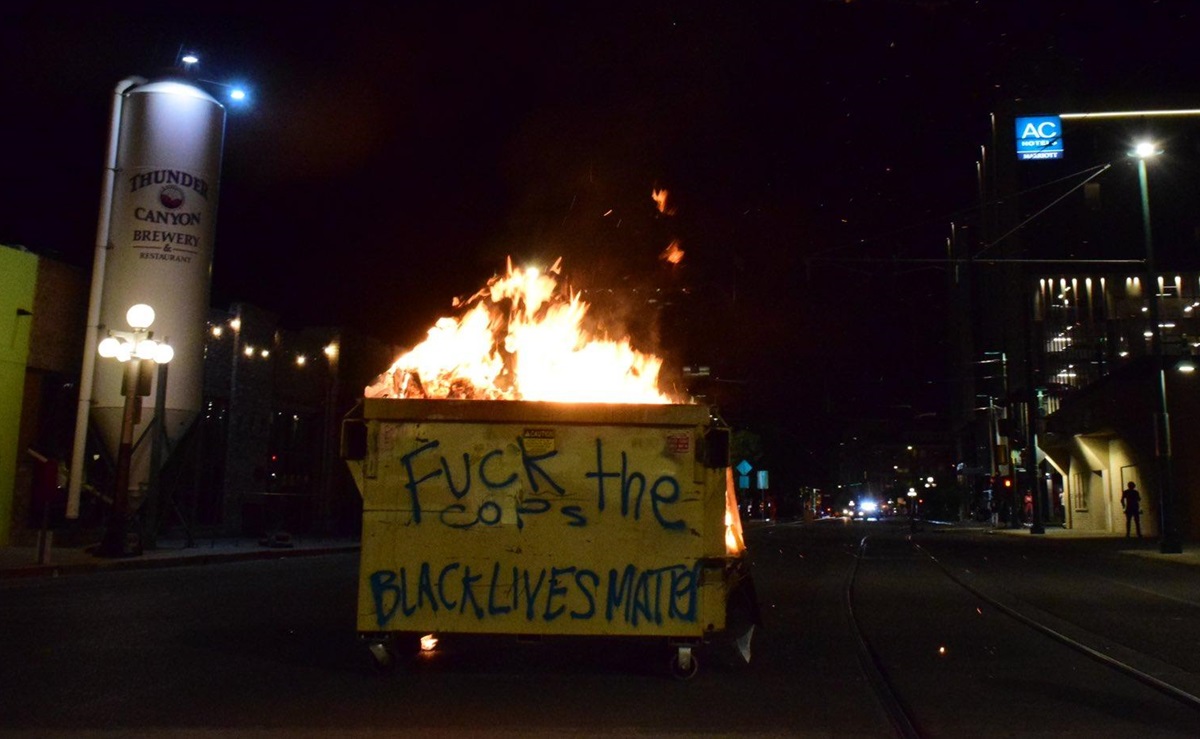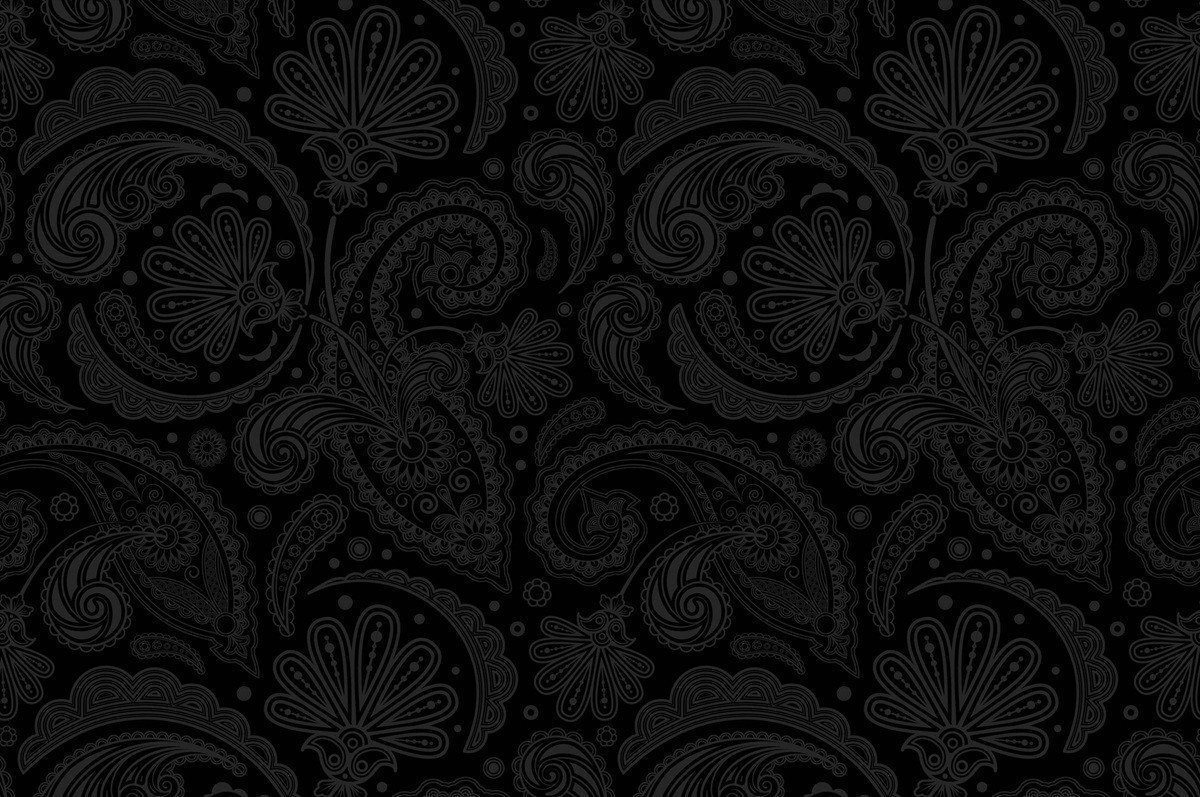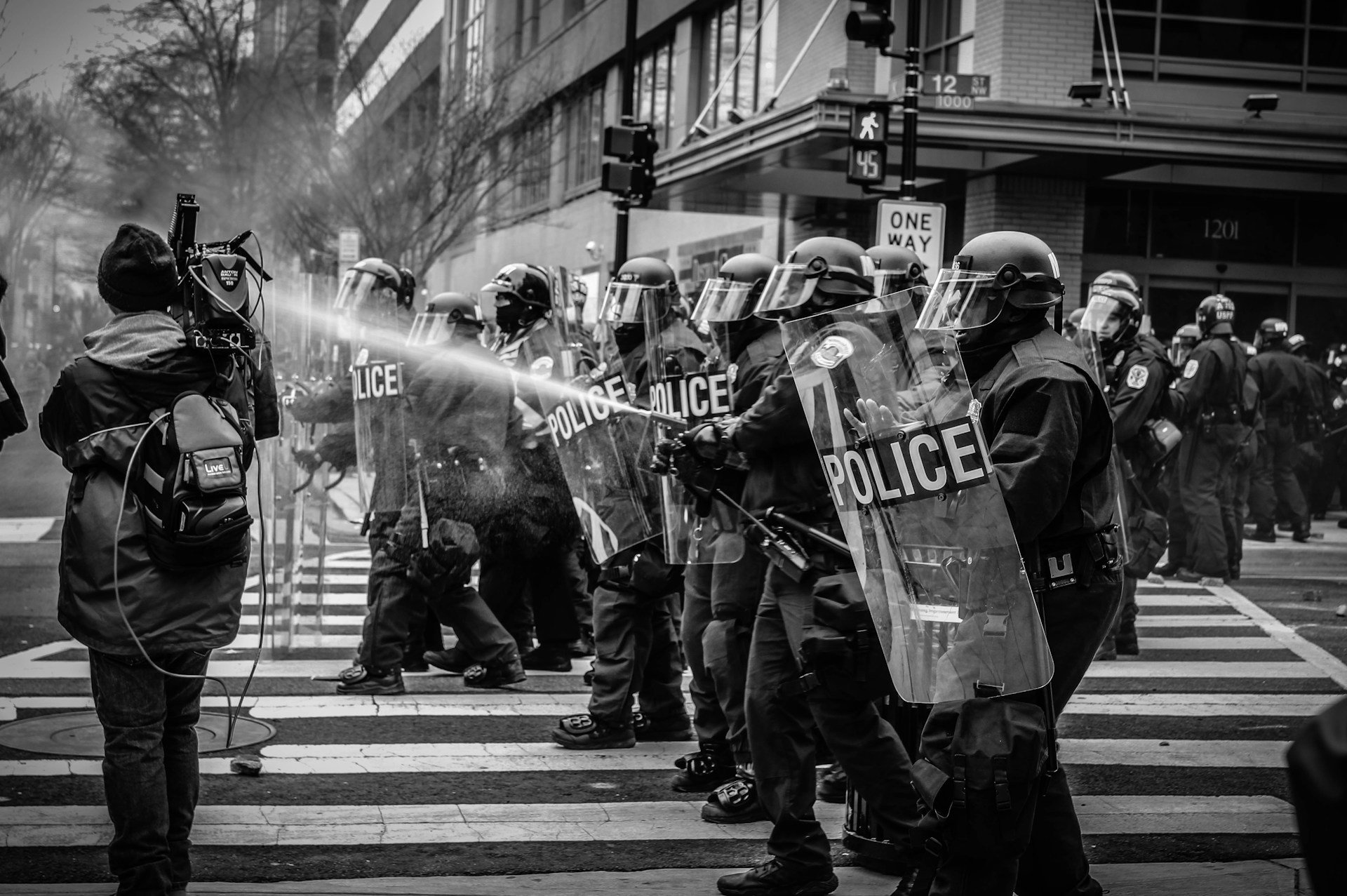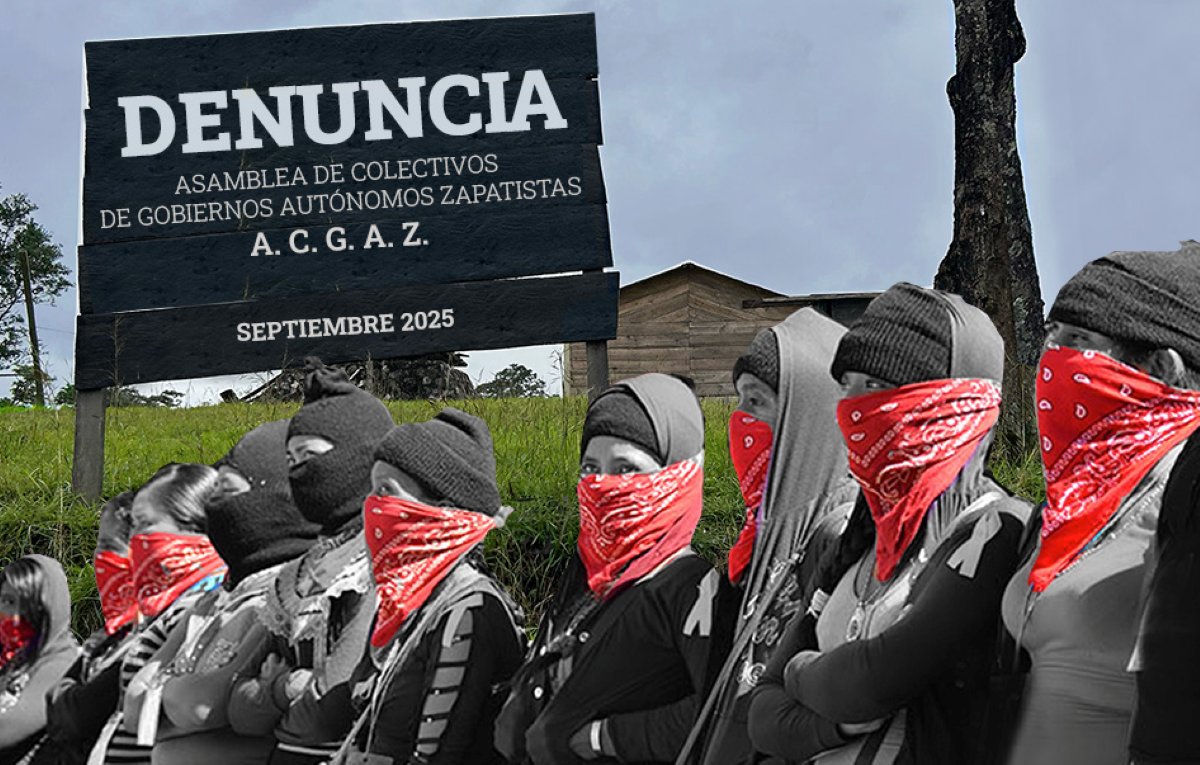Filed under: Analysis, Police, Southwest, White Supremacy

What follows is a transcription of a recent talk given in Tucson, Arizona by a participant in the George Floyd Uprising in Minneapolis in 2020.
The speaker recalls the events of the rebellion before offering analysis on how, through a counter-insurgent leveraging of race politics, it was eventually put down. For those currently in the throes of yet another cycle of struggle in which questions of race are again central, the recent history of the George Floyd Uprising offers key lessons. A selection of readings on Race Treason are available here.
By Nevada
It is not without nostalgia that I want to talk about the 2020 uprising in Minneapolis. It feels like yesterday, but it was almost four years ago. I have already met so many young people who have no direct experience of the George Floyd uprising—maybe even some of you. Those few days totally changed my life, and I don’t think I will ever stop thinking about them. It wasn’t the first rebellion of which I was a part, and wouldn’t be the last, yet the magnitude of it remains truly unparalleled.
Today, life has shifted so dramatically from that time, telling these stories helps those memories feel more vibrant just as they simultaneously make them feel more fantastic. Driving down Lake Street in Minneapolis today, it’s hard to imagine all these buildings on fire, their contents free for the taking. The campaign of forgetting, described best by Idris Robinson, has been unimaginably successful, despite the burnt remains of the third precinct sitting there for all to see.
So to fight this campaign, even just a little, I will indulge this nostalgia and walk you all through a brief overview of the four or five days Minneapolis rose up against the police and the world they maintain. Its starts on May 25, 2020 when four Minneapolis police officers murdered George Floyd. A video of the murder goes viral within hours of it happening. On social media, a call is put out to gather and protest the next day at the site of the murder—the intersection of 38th Street and Chicago Avenue, which would go on to be called George Floyd Square. This is early on in the Covid pandemic, there hadn’t been any sort of gatherings really for months, which is important to keep in mind. There were even those voices chastising people for holding a protest at all, due to the supposed “danger” it posed.
Thankfully, it doesn’t seem like anyone heeded such warnings. Instead, the protest location was overflowing with people. Many masked, and more still valuing their personal six feet, ensuring the crowd of several thousand was dispersed over an even larger area than they would normally take up. So much so that entire marches could leave from the site without others even noticing. There ended up being two main marches, both heading towards the 3rd Precinct (which is the police station that covers South Minneapolis, where George Floyd was killed) but taking opposite routes. Both of these marches would, independently of each other, encounter a handful of squad cars monitoring the protests along their respective routes, and immediately attack them. The police, aiming to avoid as much conflict as possible, quickly retreat. The marches then continue on to the precinct, eventually re-merging.
Once there, the usual protest speeches gave way to the percussive music of shattered glass as the front door was smashed, followed by the windows of every cruiser in the parking lot. The police, realizing that their usual strategy of conflict avoidance would not prevent this from escalating into a significant riot, began to move in with less-lethal munitions. Flash bangs and tear gas exploded up and down Lake Street. Yet between the massive crowd size, the arrival of rain, and the sprawling, open space, the police simply could not shut anything down. The liquor store across from the precinct is looted after nightfall, and then the police retake it, retreat, and the looting resumes, etc. It’s actually always been unclear to me if there even is a point at
which everyone clears out, before things pick up the next day—I remember being out there around 1 or 2am and there was still a few hundred or so people hanging out in the rain.
Just to make this as explicit as possible: street fighting with the police, vandalism of police infrastructure, and the looting of private property—all of this occurred on the first night of the uprising. I don’t know how many times I have heard claims to the contrary, all in service of a narrative where a peaceful protest was ruined by the arrival of outsiders. This is simply not true.
Wednesday, May 27 is the second day of the uprising. People encircle the precinct all day, with police positioned on the roof. Small scuffles break out here and there, with people throwing things and the police shooting rubber bullets into the crowd. After some hours of this, the cops make a concerted effort to retake some ground in front of the precinct. They push into the intersection, again using tear gas to clear out the crowds. With no rain to dull its sting, it does a better job of dispersing everyone. Except instead of going home, people retreat into the surrounding shopping centers, and further down Lake Street. Now even more stores start to get looted—Target, Aldi, Cub Foods, AutoZone, a smoke shop. The same liquor store as last night gets run through yet again. People are pushing shopping carts home full of groceries or car batteries, while others bring out boxes of goods to share with the crowd. As sun sets, the fires start. Some places, like the AutoZone, Wendy’s, and an under-construction condo building go up in flames rather easily, while the bigger stores have sprinkler systems that end up doing nearly as much damage as the fire by flooding the store for days.
Looting spreads further and further away from the epicenter of the precinct, crowds stretch for perhaps a mile or more in either direction on Lake Street. There are also a few reports of smash-and-grabs in the more upscale neighborhoods like Uptown. Any police not trapped by the precinct siege are either impotently responding to the mobile looting long after the vandals have gone, or attempting to escort firetrucks towards the flames. As with the night before, it’s unclear whether things ever fully petered out overnight before picking up again in the morning.
The next morning, May 28, looters descend on a large Target store across the river in Saint Paul. When police arrive to deal with the situation, battles begin in the parking lot. By the middle of the day, looting has likewise spread up and down this major commercial corridor of Saint Paul. Just to be clear, this is happening simultaneously, in broad daylight, in another whole city.
Back in Minneapolis, the police can only watch as the area around the precinct is now a free zone. Stores continue to be looted throughout the day, everyone admiring the destruction and smoke still rising off of the previous night’s wreckage. Surely, we all know that by the end of the night, the police are forced to surrender their precinct and it too is set on fire. Some speculate that part of the reason for this is that the cops inside actually ran out of tear gas, since they used so little in the moments before their retreat. The gate to their parking lot was chained shut by protesters, so they pile into as many cruisers as they have—which is not enough to fit all the officers and many are forced to run on foot—and smash into the gate hard enough to break it down, and then flee into the night under a barrage of rocks and fireworks.
After that, even more fires are set, destroying a number of buildings in the area of the precinct. Looting by car has also continued to increase and spread further and further beyond the epicenter, even beyond the city itself, to the entire metro area.
I always have to point out that this was not the climax. It’s the part we all heard about, the part people make T-shirts out of and reference in their communiques, but it’s not the crescendo. The National Guard arrive in Minneapolis sometime overnight, and retake the area around the third precinct by sunrise on May 29. But this doesn’t stop another crowd from forming, and this crowd does what any crowd should do after successfully overrunning a police station: they head to the next closest police station to do it again.
The fifth precinct is a few miles down Lake Street, which sees further looting as people make their way there. The fifth precinct covers Uptown, a more heavily gentrified area which has already seen significant looting over the past few days. Yet tonight it escalates dramatically—a large Wells Fargo office is broken into and quickly set aflame. A K-Mart already going out of business is ransacked for the last of its merchandise before it is set alight. A temp agency is shown no mercy and burns to the ground before morning. All the while, police are again trapped on their own roof, shooting rubber bullets at their assailants. While the National Guard reinforcements free up police resources enough to gain the upper hand in reclaiming the street in front of the precinct, they are still unable to intervene in the chaos enveloping the rest of the neighborhood.
Unfortunately, this is where things get complicated. It’s hard to know how to summarize it all. Try to imagine a scenario where law and order is in total disarray, and what kind of information sharing might be happening in those moments—how many rumors might spread wildly over social media, what conspiracy theories might be concocted in group chats that then spill over into public discourse. The turning point was obviously when the governor went on TV to claim the uprising was the work of white supremacists, but I would be wrong to say that it started there. It wouldn’t have made any sense. What I want to talk about is how the groundwork for understanding this claim was laid well in advance.
In claiming that the offensive acts of the uprising—specifically, the looting and arson—were being carried out by white supremacists, the entire foundation of the uprising is upended. It was now necessary, in the minds of many participants and sympathizers, to crush the uprising in its own name. By this I mean, “participating in the uprising” came to mean protecting stores from looting, forming ID checkpoints, enforcing the curfew, cleaning up broken glass, or painting over graffiti at Target. In the face of this wave of popular counter-insurgency, the uprising is unable to sustain itself beyond the fifth night.
Hopefully it goes without saying that these rumors were entirely false. The posts about how fascists are rallying in one park or another would spread like wildfire—the posts of concerned neighbors pointing out that this park is totally empty did not gain such traction. Or claims that someone had set a house on fire, only for it to come out later someone was merely seeing the smoke from a backyard fire pit. Despite all of the commotion a handful of “Boogaloo Boys” stirred up, it’s well documented they actually took up arms in defense of property, not to destroy it.
Yet if this idea was so absurd, why did people believe it? Why did they fall for the bizarre claims of politicians intent on stopping them? I believe that it’s because these claims managed to find traction not only with other conspiracy theories that were spiraling out of control on social media, but more fundamentally, with our contemporary understandings of identity and political action.
Let me use an example: during the night of May 27, a stretch of restaurants are being broken into by looters a couple miles away from the third precinct. Some, if not all, of these restaurants are immigrant-owned. A message goes out that “white supremacists are looting BIPOC restaurants.” When asked how they know the looters are white supremacists, their only evidence is that the targets are minority-owned and thus, the looters must be racist. This is only one of many anecdotes that I think helps illustrate how poorly we perceive these dynamics in the real world. I want to say it’s obvious that there are many reasons to loot a business that have absolutely nothing to do with the identity of its ownership, but my point is rather that it’s not.
On the one hand, in an effort to rebuke the more conservative condemnations of looting as “mindless crime,” activists assert the political implications of looting, and thus insist the act be understood in a grammar of protest. In this grammar, looting a store is understood as a form of expressing a grievance with this store in some way. On the other hand, even some of the most radical anti-racist activism has yet to shake its attachments to representation, in which “bipoc”-owned businesses are part of the path to liberation, not an obstacle upon it.
The extent to which such “anti-racism” has become a dominant social discourse today is not a victory of the 2020 uprising, but a consequence of its defeat. It is an operation intended to bury its memory. There is no end to the racial order without the burning of many, many more precincts, and every diversity initiative—no matter how radical it sounds—is designed to make us forget that.
And I must make myself clear that saying this is very different from saying that race isn’t important. I am not lamenting how class is being left behind by today’s activists or any such nonsense, despite how easy it might be to paint me with that brush. Rather, fighting these dynamics comes from a steadfast commitment to black liberation, which does not find adequate expression in so many of the acts that claim it today. Idris Robinson has already clarified that “much of [the] academic debate about race, which has now become everyday parlance, is actually beside the point. It is neither biological nor social: whiteness is to be measured by the degree to which a person clings to the last vestiges of this dying and doomed country… It is worthwhile to note that, according to this standard of evaluation, it follows that many of the people who are called ‘black’ must instead be judged as white.”
If this latter point from Idris is controversial, it should suffice to explain how some of the armed groups that came together in late May 2020 to protect businesses would go on to receive city contracts to outsource policing officially, during both future moments of unrest and dayto-day life. For example, the Minnesota Freedom Fighters, a black armed group that emerged in 2020 to protect businesses in north Minneapolis, would get paid to attack protesters outside the Brooklyn Center police station in 2021 after Daunte Wright was killed. Or the Agape Movement, who made a name for themselves at George Floyd Square—the barricaded memorial/autonomous zone formed at the site of Floyd’s death—would just a year later be paid to bully activists protesting against the police murder of Winston Smith just a couple miles away, not to mention helping the city in dismantling the very barricades that protected the Square too. Meanwhile AIM, the American Indian Movement, would go from rounding up teenage looters in 2020 to assisting the city evict its majority-Native homeless encampments in more recent years. The bottom line is that the racial order has a very material basis, and anyone who acts to preserve this basis—through policing, the protection of property, etc.—is an agent of white supremacy, no matter their own personal status in it.
Now, importantly for us, the flip side of this framework illuminates the possibility of race treason. That is, the possibility for those who are white or non-black people of color to take real action against the racial order, not simply accepting the deference politics so common today. Race treason was on clear display during the 2020 uprising, in Minneapolis certainly but also all around the country, as the crowds were significantly more diverse than the sixties uprisings they get compared to. And those of us for whom our activist and anarchist social scenes have always been overwhelmingly white, this is a framework in which we can think about what we can do and how we can do it. Otherwise, we will remain stuck in endless debates on legitimacy and representation that have handcuffed militants for years.
The standard described by Robinson is that “whiteness is to be measured by the degree to which a person clings to the last vestiges of this dying and doomed country.” This is a pretty high bar to clear. Back in 2020, there was an obvious answer: to join the revolt. Yet now that the fires have been reduced to mere memories, how can we still hope to take action against this order in our day to day lives? An all-too-literal reading of Robinson’s standard quickly brings us to moralism, martyrdom, and suicide. Yet it doesn’t have to.
Both this false conclusion and the anti-racism I described earlier are limited to the realm of the individual. Whether it’s communiques or Venmo payments, these two paths are really two expressions of the same ambition for moral purity. We must find a path that is truly collective, a path that can adequately grapple with the structural basis of the challenge we are facing. Otherwise, not only will we fail the revolts of our time, we may end up crushing them instead.





